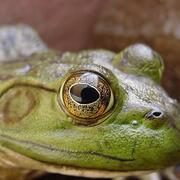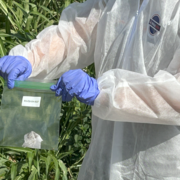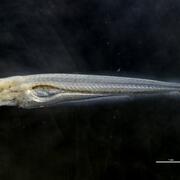Invasive Carp
Invasive Carp
Filter Total Items: 54
Battling Invaders: Invasive Species Detection with eDNA
Early detection equals stronger protection. DNA in the environment is the front line against invasive species.
By
Ecosystems Mission Area, Biological Threats and Invasive Species Research Program, Species Management Research Program, Alaska Science Center, Columbia Environmental Research Center, Eastern Ecological Science Center, Forest and Rangeland Ecosystem Science Center, Fort Collins Science Center, Great Lakes Science Center, National Wildlife Health Center, Northern Prairie Wildlife Research Center, Northern Rocky Mountain Science Center, Pacific Island Ecosystems Research Center, Southwest Biological Science Center, Upper Midwest Environmental Sciences Center, Western Ecological Research Center (WERC), Western Fisheries Research Center, Wetland and Aquatic Research Center
From Water, Soil, and Air: Building USGS Leadership in Environmental DNA (eDNA)
The USGS is a pioneer in environmental DNA (eDNA) science, applying cutting-edge molecular tools to identify, detect, or track species, monitor ecosystems, and safeguard biodiversity.
By
Ecosystems Mission Area, Biological Threats and Invasive Species Research Program, Environmental Health Program, Species Management Research Program, Alaska Science Center, Columbia Environmental Research Center, Eastern Ecological Science Center, Forest and Rangeland Ecosystem Science Center, Fort Collins Science Center, Great Lakes Science Center, National Wildlife Health Center, Northern Prairie Wildlife Research Center, Northern Rocky Mountain Science Center, Pacific Island Ecosystems Research Center, Southwest Biological Science Center, Upper Midwest Environmental Sciences Center, Western Ecological Research Center (WERC), Western Fisheries Research Center, Wetland and Aquatic Research Center , Pacific Northwest Environmental DNA Laboratory
Early Life History of Bighead, Silver, Black, and Grass Carps
Grass, bighead, black, and silver carps spawn in turbulent rivers, their eggs develop and hatch while drifting downriver. The larvae have a short period of development in the drift, and then they must swim from the mainstem of the river and find appropriate low- or no-flow nursery areas. Rivers which are not long enough, turbulent enough, or without nursery areas in the correct locations are not...
Invasive Species We Study: Invasive Carp
Bighead, black, grass, and silver carp, which are native to China, were originally stocked in aquaculture facilities to control algae, snails, and vegetation. These species escaped during flood events and are now established throughout the lower and middle Mississippi River Basins and some of its large tributaries where they damage ecosystems and harm economies. Grass carp are also reproducing in...
Flow Cytometry Applied to the Animal Kingdom in Studies of Natural Resource Science
Flow cytometry is a technique for rapidly analyzing large numbers of animal cells using light-scattering, fluorescence, and absorbance measurements.
Improve Control Efficiency Through Better Understanding of Grass Carp Movements and Habitat Use
The goal of this project is to address the threat of invasive Grass Carp by developing a comprehensive understanding of seasonal movements, habitat use, and areas of aggregation to determine when and where eradication efforts would be most effective.
Identifying Spawning Tributaries and Specific Spawning Areas of Grass Carp
Grass carp ( Ctenopharyngodon idella) is an invasive species translocated to the United States in the 1960s due to its potential for nuisance aquatic vegetation control. Following escapes, authorized stockings, and unauthorized stockings, the grass carp range rapidly expanded in the U.S.
Black Carp Biology, Assessment, and Control
Black Carp ( Mylopharyngodon piceus) is the largest of the four non-indigenous carp species, reaching sizes well in excess of 100 pounds. Scientists at the Columbia Environmental Research Center, in cooperation with federal and state partners, are studying the biology, ecology, and behavior of black carp and developing tools to monitor, assess, and control this non-indigenous species.
Siren: The National Early Detection and Rapid Response Information System
Siren: the National Early Detection and Rapid Response (EDRR) Information System is an online resource for invasive species information sharing and collaboration that serves as the information hub of the National EDRR Framework.
Fish Passage Design and Analysis at the S.O. Conte Research Laboratory
There are more than 92,000 dams in the United States, of which at least 3% of these produce hydropower. Hydropower projects create renewable energy but also can alter habitats, restrict upstream and downstream movements of fishes and other aquatic organisms, and may stress, injure or kill migrant fishes and other aquatic organisms. In addition, there are more than 5 million culverts and other road...
Laboratory evaluation of bait preference for Grass Carp
Michigan and Ohio Department of Natural Resources along with the U.S. Geological Survey (USGS) Columbia Environmental Research Center (CERC) and USGS Upper Midwest Environmental Science Center (UMESC) are planning field studies to attract Grass Carp using formulated baits and algae attractants. These baits are intended to increase the density of Grass Carp in specified areas for capture and...
Method development for intestinal cannulation to dose filter feeding fishes
Currently, the only U.S. Environmental Protection Agency (USEPA) registered pesticide for resource managers to control populations of Invasive Carp (e.g., Bighead Carp, Hypophthalmichthys nobilis) are rotenone (Prenfish Fish Toxicant; EPA Reg. No. 89459-85) and Carbon Dioxide – Carp (EPA Reg. No. 6704-95). An alternative to rotenone and Carbon Dioxide – Carp, antimycin-A (ANT-A), is desired by...













